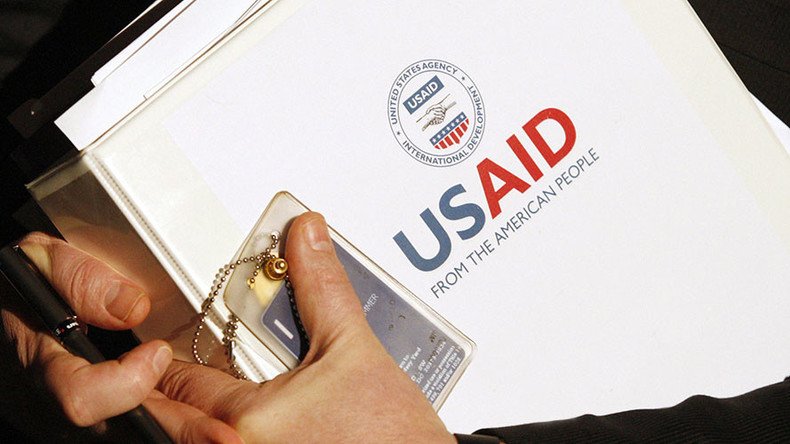Trump’s budget cuts could ‘eviscerate’ USAID

The Trump administration’s budget proposal includes cuts of one to two-thirds in funding to the USAID program, the government’s foreign aid agency. If passed, the cuts could threaten missions, jobs and worsen the migrant crisis.
The proposed slash in funding would eliminate 30 to 35 of United States Agency for International Development’s (USAID) field missions while cutting its regional bureaus by roughly 65 percent, according to a 15-page State Department budget document on the overhaul, obtained by Foreign Policy.
USAID currently operates in about 100 countries.
President Donald Trump is seeking a cut to foreign aid under the slogan of “America First,” for fiscal year 2018.
The State Department and USAID budget request for this fiscal year is around $50 billion, part of a broader $58.8 billion “international affairs budget,” but a drop in the overall $3 trillion-plus federal budget.
#Trump’s budget cuts State Dept, keeps foreign aid to #Israel, silent on other countries https://t.co/48QRnmNzxqpic.twitter.com/3dRHeVeNeI
— RT America (@RT_America) March 17, 2017
“What you’re basically doing is eviscerating the most important tool of American influence in the developing world, which is our development program,” Andrew Natsios, the former USAID administrator under the Bush administration told Foreign Policy. “I don’t think they understand what the role of USAID is, what USAID’s mission directors are. USAID’s mission directors are among the most influential foreigners in the country.”
The cuts proposed by the Trump administration would help offset some $54 billion in additional military spending. Trump administration officials have indicated much of the cuts to state and USAID would target foreign aid programs.
The budget plan still requires approval by Congress.
A shift: Trump’s budget requests $54 bn defense increase, while slashing other departments https://t.co/2wd2eo7El9
— RT (@RT_com) March 16, 2017
Some of the cuts appear directed at countries that had been regarded as strategically important to the US. For instance, foreign assistance to Ukraine, used to encourage political and economic reform, is facing a 68.8 percent cut.
The proposal would likely require dramatic restructuring and staffing cuts at the State Department and USAID, responsible for US diplomacy and foreign aid respectively.
Secretary of State Rex Tillerson supports the proposed cuts to the State Department. He called the budget “an acknowledgement that development needs are a global challenge to be met not just by contributions from the United States but through greater partnership with and contributions from our allies and others.”
Natsios thinks Tillerson needs to examine the data and said before the cuts, the US ranked 22nd out of all the wealthy countries making contributions to development aid.
The USAID agency grew out of the Marshall Plan which began after WWII, providing financial and technical assistance to Europe after the war. The program allowed Europe to rebuild its infrastructure, strengthen its economy and stabilized the region. The program was expanded under the Truman, Kennedy and Bush administrations.
In addition to closing missions, global health funding is also targeted for a 25 percent cut. Trump said he will continue to provide funding for the President’s Emergency Plans for AIDs Relief proposals, but 41 countries face health cuts.
The support of the US played a big role in managing the Ebola pandemic that engulfed three African countries, and led to the deaths of 100,000 people according to the US Centers for Disease Control and Prevention.
“I’ve seen firsthand how US development money saves millions of lives,” said Tom Kenyon, the CEO of Project Hope, a global health nonprofit. “There’s just no question people would die from this.”
The proposed cuts are also coming when there is mass migration of people around the world leaving their countries.
“The question is, why are they leaving? The way you deal with that is to build sustainable institutions in those countries that can deal with the problems so that people don’t leave their countries,” Natsios told National Public Radio.
Natsios said Islamic State is threatening to destabilize “friends and allies in Africa and the Middle East.”
“[P]art of that is a military solution, but it also is improving the school systems, improving public services, improving public services, improving the health systems in these countries so that there isn’t an appeal from these radical groups.
Governance improvement is not done through DoD. It’s not done through hard power. It is done through soft power,” he told NPR.
The Bureau of Food Security is slated to lose 68 percent of its funding which would reduce development aid geared toward preventing food shortages.
Other programs on the chopping block include the ambassador-at-large for global women’s issues, the Office of the Coordinator for Cyber Issues, and the Trans-Sahara Counterterrorism Partnership.
The biggest cut is 94.5 slash in funding for the State Department’s Bureau of Oceans and International Environment and Scientific Affairs – the roughly $1 billion the US draw on for contributions to the Green Climate Fund, which is dedicated to curbing carbon emissions. The fund is part of the US’ commitment under the 2016 Paris climate agreement that aims to keep global temperatures from rising beyond two degrees Celsius.
There is no money slated for development assistance to 77 countries and regional offices, and redirects the money to the economic support fund.













